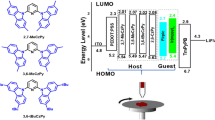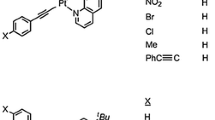Abstract
Organic electron-transport materials are an essential component to boost performances and stability of organic light-emitting diodes. We present a robust organic electron-transport compound 3-(6-(3-(4,6-bis(4-biphenylyl)-l,3,5-triazin-2-yl)phenyl)pyridin-2-yl)phenyldiphenylphosphine oxide by facilely coupling the triphenylphosphine oxide moiety to the 2-phenyl-4,6-bis(4-biphenylyl)-1,3,5-triazine unit via a 2,6-pyridinylene linker. It is well soluble in weakly polar solvents and possesses a high Tg of 123 °C with an exceptional Td≈470 °C at 1% weight loss and deep HOMO/LUMO levels of ca. −6.45/-3.06 eV. The phos-phorescent spectrum measured in solid state at 77 K reveals a notable triplet energy of 2.88 eV. n-Doping with 8-hydroxyquinolatolithium (Liq) produces the electron mobility value of 4.66×10−5-3.21×10−4 cm V−1s−1 @(2–5)×10−5 V cm−1. Moreover, the contrasting solubility of the bromo reaction intermediate and the new compound in alcoholic solvents facilitates separation. The characterizations of bottom- and top-emission green phosphorescent OLEDs involving this single Liq-doped electron-transport layer reveal long stability. In particular, the latter provides outstanding performances with 77.4 cd A−1 (corresponding to an EQE of 18.7%) and 86.8 lm W−1@ca. 1000 cd m−2, based on the green emitter bis(2-phenylpyridine)(2-(4-methyl-3-phenylphenyl)pyridine)iridium(III). Moreover, driven by a constant current for ca. 640 h, the initial luminance of 1000 cd m−2 appears almost no decay.
Similar content being viewed by others
References
Tang CW, VanSlyke SA. Appl Phys Lett, 1987, 51: 913–915
Kido J, Hongawa K, Okuyama K, Nagai K. Appl Phys Lett, 1994, 64: 815–817
Kido J, Hayase H, Hongawa K, Nagai K, Okuyama K. Appl Phys Lett, 1994, 65: 2124–2126
Lamansky S, Kwong RC, Nugent M, Djurovich PI, Thompson ME. Org Electron, 2001, 2: 53–62
Jin G, Liu JZ, Zou JH, Huang XL, He MJ, Peng L, Chen LL, Zhu XH, Peng J, Cao Y. Sci Bull, 2018, 63: 446–451
Tanaka M, Noda H, Nakanotani H, Adachi C. Adv Electron Mater, 2019, 5: 1800708
Meerheim R, Scholz S, Schwartz G, Reineke S, Olthof S, Walzer K, Leo K. Proc SPIE, 2008, 6999: 699917
Tan WY, Zou JH, Gao DY, Liu JZ, Chen NN, Zhu XH, Peng J, Cao Y. Adv Electron Mater, 2016, 2: 1600101
Wei XF, Tan WY, Zou JH, Guo QX, Gao DY, Ma DG, Peng J, Cao Y, Zhu XH. J Mater Chem C, 2017, 5: 2329–2336
Fleissner A, Stegmaier K, Melzer C, von Seggern H, Schwalm T, Rehahn M. Chem Mater, 2009, 21: 4288 1298
Becker H, Bach I, Holbach M, Schwaiger J, Spreitzer H. SID Symposium Digest, 2010, 41: 39–42
Fujimoto H, Yahiro M, Yukiwaki S, Kusuhara K, Nakamura N, Suekane T, Wei H, Imanishi K, Inada K, Adachi C. Appl Phys Lett, 2016, 109: 243302
Von Ruden AL, Cosimbescu L, Polikarpov E, Koech PK, Swensen JS, Wang L, Darsell JT, Padmaperuma AB. ChemMater, 2010, 22: 5678–5686
Tan WY, Wang R, Li M, Liu G, Chen P, Li XC, Lu SM, Zhu HL, Peng QM, Zhu XH, Chen W, Choy WCH, Li F, Peng J, Cao Y. Adv Fund Mater, 2014, 24: 6540–6547
Yin X, Zhang T, Peng Q, Zhou T, Zeng W, Zhu Z, Xie G, Li F, Ma D, Yang C. J Mater Chem C, 2015, 3: 7589–7596
Chakravarthi N, Gunasekar K, Cho W, Long DX, Kim YH, Song CE, Lee JC, Facchetti A, Song M, Noh YY, Jin SH. Energy Environ Sci, 2016, 9: 2595–2602
Naik S, Kumaravel M, Mague JT, Balakrishna MS. Inorg Chem, 2014, 53: 1370–1381
Hung WY, Fang GC, Lin SW, Cheng SH, Wong KT, Kuo TY, Chou PT. Sci Rep, 2014, 4: 5161
Jia J, Zhu L, Wei Y, Wu Z, Xu H, Ding D, Chen R, Ma D, Huang W. J Mater Chem C, 2015, 3: 4890–4902
Zhang H, Tan WY, Fladischer S, Ke L, Ameri T, Li N, Turbiez M, Spiecker E, Zhu XH, Cao Y, Brabec CJ. J Mater Chem A, 2016, 4: 5032–5038
Wang K, Neophytou M, Aydin E, Wang M, Laurent T, Harrison GT, Liu J, Liu W, De Bastiani M, Khan JI, Anthopoulos TD, Laquai F, De Wolf S. Adv Mater Interfaces, 2019, 6: 1900434
Seitkhan A, Neophytou M, Kirkus M, Abou-Hamad E, Hedhili MN, Yengel E, Firdaus Y, Faber H, Lin Y, Tsetseris L, McCulloch I, Anthopoulos TD. Adv Funct Mater, 2019, 29: 1905810
Chen NN, Tan WY, Liu JZ, Zhou JH, Gao DY, Chen LL, Peng JB, Cao Y, Zhu XH. Org Electron, 2017, 48: 271–275
Fink R, Frenz C, Thelakkat M, Schmidt HW. Macromolecules, 1997, 30: 8177–8181
Hirai M, Tanaka N, Sakai M, Yamaguchi S. Chem Rev, 2019, 119: 8291–8331
Acknowledgements
This work was supported by the National Key Research and Development Program of China (2016YFB0400701), Natural Science Foundation of Guangdong Joint Program (U1801258, U1301243), and Department of Science and Technology of Guangdong Province (2019B010924003).
Author information
Authors and Affiliations
Corresponding authors
Ethics declarations
Conflict of interest The authors declare that they have no conflict of interest.
Supporting Information
11426_2020_9714_MOESM1_ESM.pdf
Molecular engineering of an electron-transport triarylphosphine oxide-triazine conjugate toward high-performance phosphorescent organic light-emitting diodes with remarkable stability
Rights and permissions
About this article
Cite this article
Chen, LL., Peng, L., Wang, LY. et al. Molecular engineering of an electron-transport triarylphosphine oxide-triazine conjugate toward high-performance phosphorescent organic light-emitting diodes with remarkable stability. Sci. China Chem. 63, 904–910 (2020). https://doi.org/10.1007/s11426-020-9714-0
Received:
Accepted:
Published:
Issue Date:
DOI: https://doi.org/10.1007/s11426-020-9714-0




